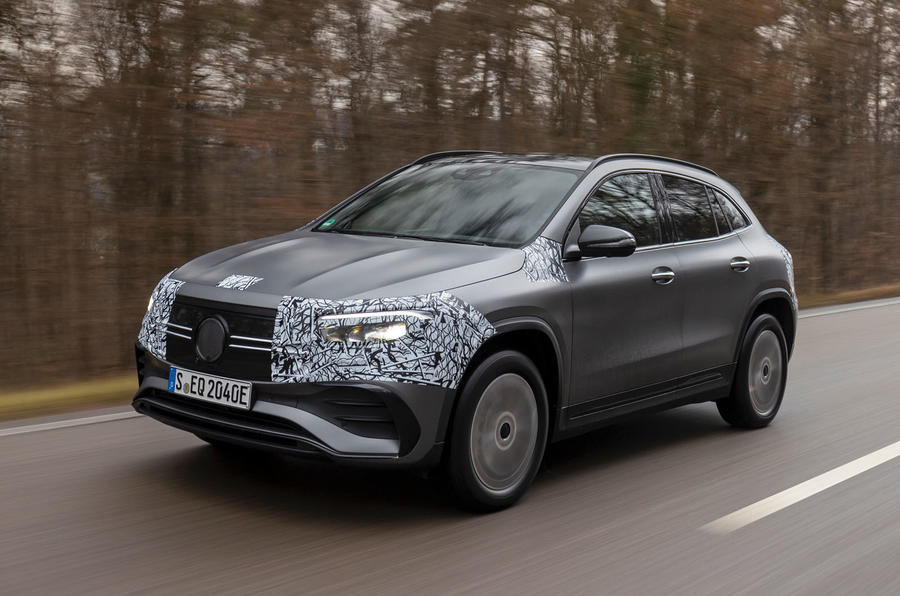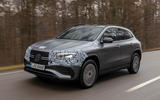The logic behind Mercedes-Benz’s decision to lift the various petrol, diesel and plug-in hybrid drivetrains out of the engine bay of the Mercedes-Benz GLA and replace them with an electric motor to create the new EQA is easy enough to understand.
Without a dedicated EV platform to underpin the most affordable of its EQ-branded models, the German manufacturer really didn’t have much choice other than to rely on existing hardware if it was to make good on its promise of delivering an electric compact SUV priced to rival the BMW i3 and Volkswagen ID 3. The creation of a unique structure, like those used by its key competitors, would have taken years and cost billions.
It’s not an ideal situation. The GLA’s MFA platform was conceived to support electrification but only in plug-in hybrid form, not a fully electric powertrain. As such, its high-strength steel and aluminium structure required a good deal of re-engineering – most notably to house the 66kWh lithium ion battery, which is mounted within the rear section of a raised floor, including beneath the rear seats.
However, using the GLA as a base did allow Mercedes to produce the EQA alongside its popular compact crossover at its plant in Rastatt, Germany, as well as at others, including in Beijing, China, for some handsome economies of scale.
It also paves the way for a second model off a lengthened version of the same structure, in the form of the upcoming EQB – a pure electric version of the slightly larger Mercedes-Benz GLB. Together, they’re among six new electric models planned to be launched by Mercedes before 2023.

Before all that, we’ve been invited to drive the EQA in some decidedly cold and wintery conditions in Germany. Our lightly disguised example belongs to a fleet of preproduction prototypes that are conducting durability testing ahead of UK deliveries commencing in mid-2021. It’s described as being ‘customer-ready’ and wears an AMG Line styling package, which is one of three planned.
Keen observers will immediately recognise the similarities between the EQA and its ICE sibling; they share the same steel bodyshell and bumpers. The electric model does at least receive its own unique, blanked-off grille and some other mildly altered details, although on the whole the connection is clear.






















Join the debate
Add your comment
Who wants to wait 30 minutes to add 100 miles range?
This is a tall car, so why can't they raise the rear seat if the floor is higher? Sitting with your kness raised so much sounds uncomfortable to me.
You've got to hand it to Mercedes for offering this new EQA which is based on a 9 year old platform and design, the one that underpinned the previous A Class and GLA. And which follows on from the EQC which is based on what will soon be replaced C Class and GLC rather than the new models. Premium prices for previous generation engineering from a premium company who still continue to try to cut corners. Their dark days of the late1990s hasn't been fully shaken off.
This new EQA looks very similar to the current GLA inside but platform wise the article says MFA and not the new MFA2 which underpins the latest A Class, GLA and GLB. I agree with the EQC, a current generation Mercedes which was spun off from essentially a previous gen design and platform. Either way Mercedes does seem to be lagging behind massively in the EV game by still not having bespoke platforms for volume EVs or not having a ICE platform that doesn't require substantial changes for an EV model, which is even more bizarre if transpires that the EQA is based on the latest MFA2 platform which is only a couple of years old or so. If for example, VW Group, PSA and BMW can easily deliver flexible platforms which also cater for EVs without huge changes, surely this wasn't beyond Mercedes' ability to do the same? Ironic really that the 1st A Class was designed so that it could be petrol, diesel and electric powered and yet Merc's smallest EV is potentially based on a platform that wasn't.